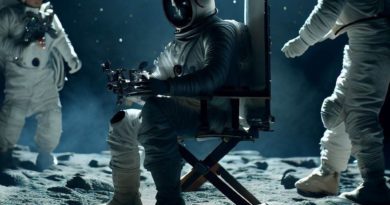See Photos of How Astronauts Trained for the Apollo Moon Missions
How do you prepare to send someone to a place no one has ever gone before? For NASA in the 1960s, the answer was to create simulations that mimicked aspects of what astronauts could expect to encounter.
Take gravity, for example. Gravity on the moon is about one-sixth of what it is on Earth. To simulate the moon’s gravity, NASA scientists suspended research subjects sideways at an angle and had them walk along a tilted wall. They took detailed notes about the subject’s ability to walk, jump and run when they performed these simulations at Langley Research Center in Hampton, Virginia. This helped them get a sense of how reduced gravity might impact an astronaut’s ability to move on the moon.
But before astronauts could walk on the moon’s lower-gravity atmosphere, NASA needed to figure out how to land them there. For this task, NASA and Bell Aerosystems designed the Lunar Landing Research Vehicle, and later the Lunar Landing Training Vehicle that the Apollo 11 crew used to practice at the Manned Spacecraft Center in Houston, Texas. These vehicles could simulate the moon’s gravity with a turbofan engine that supported five-sixths of the craft’s weight. Neil Armstrong, commander of the Apollo 11 mission, said the historic moon landing on July 20, 1969 wouldn’t have been successful without this type of simulation.

Astronaut Neil Armstrong alongside the Moon landing research vehicle, made by Bell, at Edwards Air Force Base, 1964.
Ralph Morse/The LIFE Picture Collection/Getty Images
NASA also used fake moonscapes to help astronauts practice certain parts of their mission. In an indoor moonscape in Houston, Apollo astronauts practiced using the tools they’d need to collect samples while wearing their spacesuits. Once astronauts Armstrong and Buzz Aldrin made it to the moon, they were well-equipped to use these tools, and collected 47 pounds of lunar samples to bring back to Earth.
In addition, NASA and the U.S. Geological Survey actually recreated a part of the moon’s surface in Cinder Lake, Arizona. NASA picked Cinder Lake because it was formed by a volcanic explosion in 1064, meaning it had a similar composition to what is now known as Mare Tranquillitatis, a plain on the moon formed by ancient volcanic explosions. In July and October of 1967, the USGS blasted 143 craters in Cinder Lake to create a site that looked topographically similar to Mare Tranquillitatis. For a second Crater Field, they aimed to replicate the ages of the plain’s craters. NASA began using the Crater Fields to prepare the Apollo 15 crew for their July 1971 mission, which focused on geology.
Astronauts throughout the Apollo missions also studied rock formations at the Grand Canyon and in Iceland—which is the nearest one can get to moonscape conditions on Earth—to prepare for their journeys. During the six Apollo missions in which humans landed on the moon, these astronauts brought back 2,200 samples of the moon’s surface for us to study here on Earth.
August 17, 1962: The Lunar Rendezvous Simulator at Langley Research Center.
December 11, 1963: A test subject being suited up for studies on the Reduced Gravity Walking Simulator at Langley Research Center. This sideways position meant that a person’s legs experienced only one sixth of their weight, which was the equivalent of being on the lunar surface. The purpose of this simulator was to study the subject while walking, jumping or running. Researchers conducted studies of various factors such as fatigue limit, energy expenditure, and speed of locomotion.
1964: Dr. E. Dale Jackson, U.S. Survey Geologist, with Astronauts Neil Armstrong, Richard Gordon and Don F. Eisele during Geological Training in the Grand Canyon, Arizona. This training helped astronauts better understand the potential moonscape conditions.
December 1, 1964: A concept of a possible Lunar Roving Vehicle (LRV) built by the Grumman Industries for NASA’s Marshall Space Flight Center, going through a full fledged test, complete with space suit attire.
June 7, 1966: This motorized mockup of a small LRV was built by the Brown Engineering company of Huntsville, Alabama. It weighed about 1,200 pounds and was almost 10 feet long, over 7 feet wide, and nearly 8 feet high.
Scroll to Continue
April 11, 1967: This multiple exposure shows a simulated Moon landing of the Lunar Excursion Module at Langley’s Lunar Landing Research Facility.
July 9, 1967: 21 NASA Astronauts during a week in Iceland, where they studied the geology of the island, which is the nearest one can get to moonscape conditions on Earth.
February 12, 1969: A test engineer drives a Mobility Test Article through the mountains of Arizona to figure out the best way to allow Apollo astronauts a greater range of mobility during lunar exploration missions.
February 12, 1969: The Lunar Excursion Module (LEM) was used to practice lunar landing techniques. Neil Armstrong is pictured alongside the LEM at the Lunar Landing Research Facility.
April 22, 1969: Astronauts Buzz Aldrin (left) and Neil Armstrong participate in a simulation of deploying and using lunar tools, on the surface of the moon, while wearing their Extravehicular Mobility Units during a training exercise. In the background is a Lunar Module mock-up.
June 20, 1969: Neil Armstrong flies the Lunar Landing Training Vehicle, practicing take-offs and landings. He flew the craft to an altitude of some 300 feet.
July 14, 1969: Astronaut Buzz Aldrin in his space suit practicing with the movie camera he will use on the Apollo 11 mission.
Want more HISTORY? Check out these stories:
How Landing the First Man on the Moon Cost Dozens of Lives
Apollo 11 Moon Landing Timeline: From Liftoff to Splashdown














